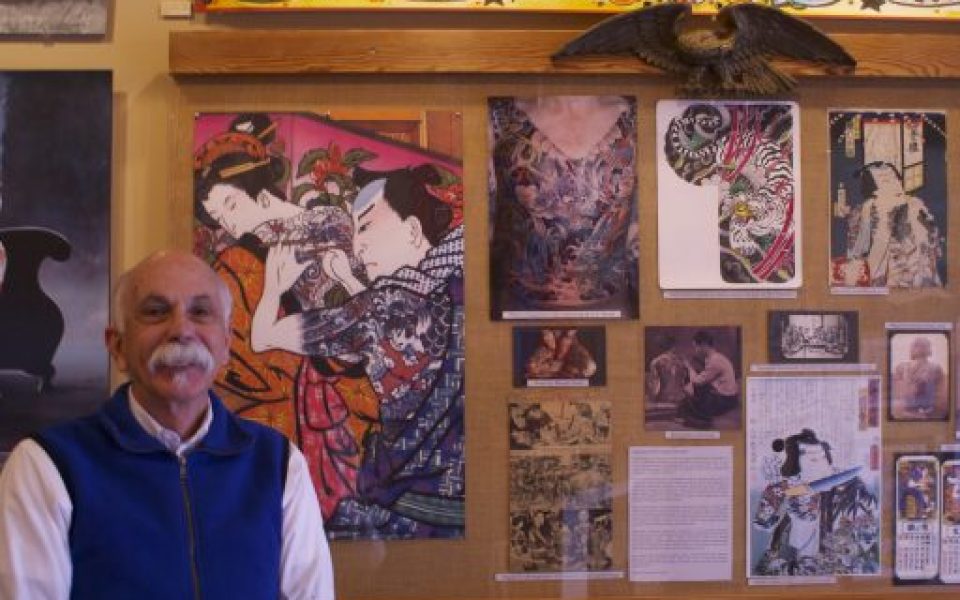by Anthony Harrison
You don’t even notice it anymore.
You might see someone with an elaborate sleeve tattoo of dragons. You might spot a Japanese character on someone’s wrist or ankle — and figure it actually means “clueless.”
Japanese tattoo art has so thoroughly embedded itself into American culture, you don’t consider the history behind it.
Tattoo Archive’s newest exhibit on Japanese tattooing informs us of a rich tradition, one going back thousands of years.
The exhibit in Tattoo Archive — a fixture of downtown Winston-Salem — features posters, woodblock prints, photographs, postcards and short essays detailing the history of the Japanese art. Many of the pieces come from owner CW “Chuck” Eldridge’s personal collection.
“We do a lot of research on the history of tattooing, and it’s hard to ignore the Japanese influence,” Eldridge said.
The exhibit pays special attention to irezumi — the traditional style of Japanese tattooing. Irezumi tattooing covers nearly the entire body, from the neck to the knees, “like a kimono,” Eldridge said. Many designs depict vivid, colorful scenes reminiscent of Oriental woodblock paintings — koi carp, tigers, chrysanthemums. One hand-tinted postcard shows the stylistic ideal: a man leaning against a fence, bare-backed but for the sprawling, green-and-red portrait of a furious samurai.
As Eldridge explained, the Western world first caught on to the Japanese style of tattooing following Commodore Matthew Perry’s expedition to the country in 1853.
“Perry’s move was controversial at the time,” Eldridge said, “but it led to the promotion of Japanese culture on all levels. It opened the floodgates, and Japanese tattooing was one part of it.”
According to Eldridge, westerners only glimpsed Japanese tattooing through photographs and postcards smuggled from the islands. But the seeds of curiosity planted themselves
firmly in the Western imagination.
“Once Americans and Europeans are exposed to something, a percentage of the population will want a piece of that,” Eldridge said. “And you can’t put up a fence saying, ‘You can look at this, but you can’t wear it.’”
Surely, the Japanese style worked its way into Western styles.
This melding can most prominently be seen in the work of one of the most famous tattooists of all time — Norman Keith Collins, better known as “Sailor Jerry.”
“In the 1950’s, Sailor Jerry made an American blend with Tokyo and Yokohama,” Eldridge said. “Though it was still American, it had that Japanese flair.”
Following his death, Collins’s protégés continued spreading irezumi.
“Ed Hardy made a career out of Japanese-style bodysuits,” Eldridge said.
Other pieces outside the exhibit show the mix of East and West.
Books, prints and posters line the long, whitewashed walls of Tattoo Archive, but one print in particular — a woodblock-styled painting by Japanese-American artist Masami Teraoka — shows a Japanese woman disgusted by a McDonald’s hamburger while a Caucasian woman slurps noodles.
Though westerners adopted Japanese tattooing whole-heartedly, the rich tradition varies in popularity, even legality, in its home country.
“Tattooing has been viewed as an underworld, commoner activity,” Eldridge explained. “Through the generations, people in power have fluctuated on their opinion regarding tattooing. It pushes a lot of buttons.”
The opening of Japan to the West had unintended consequences with regards to tattooing. Soon after Perry’s visit, the Meiji government made tattooing illegal until 1948.
At times, tattooing even served as punishment.
“The government used tattooing as a way to brand criminals,” Eldridge said. “They’d start tattooing a five-stroke Japanese character on the criminal’s forehead, and if it was complete, you were the lowest of the low.”
Even after the ban lifted, tattooing remained underground. Irezumi tattooing in particular was taken up by the infamous yakuza — the Japanese mafia.
“Up until about the 1970’s, tattooing went on, but you could walk by and never know a shop was there,” Eldridge said. “There was no advertising, no visibility, shops were invite-only.”
However, Japanese youths began getting American-style tattoos of Elvis and other rockabilly artists.
“Tattooing is being taken away from the yakuza,” Eldridge said, “but that doesn’t happen overnight. The stigma gets in the way, and the Japanese government has a way to go before they recognize the tattoo as art.”
Eldridge believes attitudes are shifting, and the Japanese tradition will soon be fully embraced.
“Tattooing is art,” Eldridge said, “and I think of tattooing as the people’s art.”
You can find Tattoo Archive at 618 West 4th Street, where they’re open on Monday through Saturday from noon to 8 p.m. The exhibit runs until March 31.
Join the First Amendment Society, a membership that goes directly to funding TCB‘s newsroom.
We believe that reporting can save the world.
The TCB First Amendment Society recognizes the vital role of a free, unfettered press with a bundling of local experiences designed to build community, and unique engagements with our newsroom that will help you understand, and shape, local journalism’s critical role in uplifting the people in our cities.
All revenue goes directly into the newsroom as reporters’ salaries and freelance commissions.



Leave a Reply